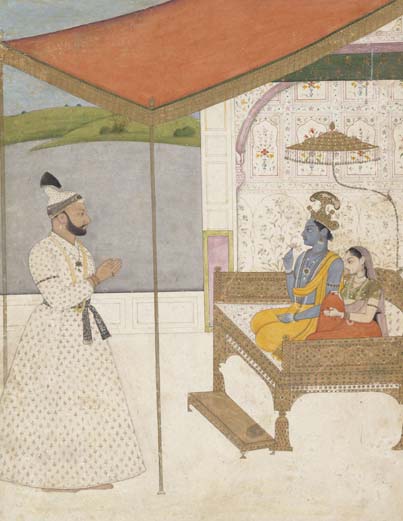
The Unknown Artists and their Works
One of the most noted artists was Farrukh Beg whose work can be seen in major works of Akbar’s reign such as Babarnama and Akbarnama. An acclaimed work is ‘A Sufi Saint, after the European personification of melancholia, Dolar’. This image inspired by European art, is almost autobiographical, a self-portrait of the artist Farrukh Beg himself.
Basawan was a young Hindu artist in Akbar’s atelier and was involved with almost all of the magnificent manuscripts produced during the emperor’s reign, including the Humzanama series. His son Manohar was a court artist for four decades and served two emperors.
Payag and Balchand were a Hindu brothers, both artists in Akbar’s court. Payag was a minor artist but gained a major role during the reign of Shah Jahan, creating many works including ‘Shah Jahan riding a stallion’, which is a page from the Kevorkian album.
What is particularly intriguing is the large number of family connections amongst the artists – brothers, uncles and cousins were employed in the same workshops. For the art detectives at the museum, it was possible to trace a family style across several generations of painters. For instance, you have the Nurpur Masters – three generations of artists from Nupur – Kripal, son Devidasa and grandson Golu. They all did a series of illustrations for the Rasamanjiri text, among many other works.
Writes Jorrit Britschgi in his essay on the Late Mughal painting and the Renaissance of the Hindu Courts, “Each workshop maintained a fund of drawings that represented the artistic legacy of whole families and that could be adapted to the taste of the time and a given ruler when necessary.”
Having investigated the lush topography of these miniatures, you discover entire worlds – of architecture, battle scenes, gods and goddesses, landscapes, portraits, love stories, flora and nature all captured in minute detail. The vibrant colors, the jewel tones, the fine brush-strokes, all these take you into a world which is real and surreal, a world of great texts from the Jainesque Shahnama to the Bhagavata Purana to the Akbarnama which told the stories of the past. And you can now see the hand of flesh-and-blood human beings who worked on these great works of art.
In the end, however, court painting itself was done in by the arrival of the new kid on the block – photography. In the beginning, the mediums of painting and photography were mixed, as in portrait photographs of royalty which were hand-colored, sometimes by court artists such as Shivalal, using oil and water-based pigments.
In the final gallery, you see an extraordinary image – a portrait photograph of the court painter Mohanlal posing with his camera. The albumen print was the favored format for early photographers in India, used almost as a business card. At this time royal courts had started hiring photographers in the way painters were employed and soon commercial photographic studios sprung up.
Time had moved on.
Related Article
Tracking Anonymous Indian Master Artists
(C) Lavina Melwani
(This article first appeared in Housecalls, India)
Credits on next page
